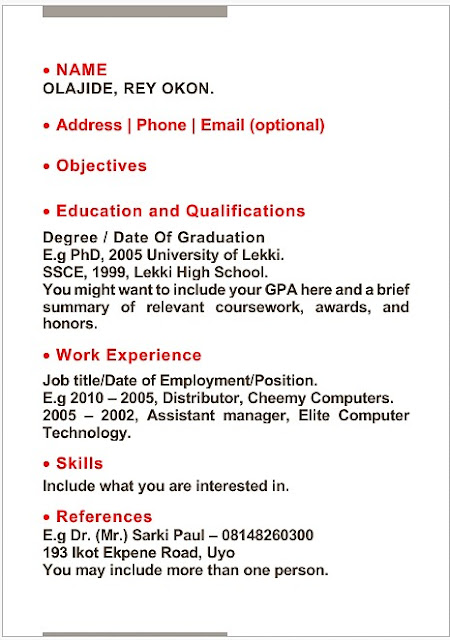Composing A Good Curriculum Vitae (CV) And Cover Letter.
What is a Curriculum Vitae (CV)?
A CV is a written record, (consisting of a person's details like education, qualifications, and the kind of job he/she must have done) that is sent alongside a cover letter to a company or an organization when applying for a job. A Curriculum Vitae can also be referred to as a Resume.
A well-written, appropriate, and organized CV is important for getting an employee to the interview stage of the job he or she applied for. But it's obvious that most people still find it difficult to put up a nice CV that could prompt acceptability by the manager of a particular company or organization.
To that effect, here are some tips that could help an individual to compose a good and acceptable CV;
- Your CV should be short and if possible, it should not be more than three pages.
- It should be attractive and well-organized.
- It must be modified to address you positively.
- Use a clean white paper, most preferably an A4 sheet, to write or type your CV.
- It must be adapted to suit the kind of job you seek for.
- It should possess the following major features:
- Name: Here, you write your name in full. You may begin with your surname or first name.
- Address, Phone Number, Email (which is optional).
- Objective: State your aim or what you plan to achieve during the course of working with the company or organization.
- Education and Qualifications: Outline your educational achievements, where you studied and the year it all started with all beginning from the recent year, school and qualifications down to the past.
- Work Experience: State out the places you had worked before, the positions you held and the years you began, beginning from the recent work down to the past works.
- Skills: You can include your hobbies, favorite activities of enthusiasm, language etc.
- References: Include names of persons whom people can be referred to. It may be your family member or a responsible person outside your family.
Below is a clear format of how a CV should look like;
Cover Letter
CVs do not stand on their own, rather, they are attached along side a cover letter when going for a job application.
A cover letter contains extra information, intentions and opinions not found in the CV. It always takes the format of a good formal letter, and as such has the same features of a formal letter, which are ;
- Writer's Address
- Date
- Recipient's Address
- Salutation
- Letter Title
- Content of the letter with good paragraphing and punctuation.
- Closure; which could be Yours faithfully or Yours sincerely.
- Signature and Name.
An employee must avoid writing what has already been written in the CV inside a cover letter. He or she must modify the tone of the letter to be pleasant and polite.





Comments
Post a Comment